
Sindal is a railway town on the island of Vendsyssel-Thy at the top of the Jutland peninsula in northern Denmark. It has a population of 3,085 and is located in Hjørring Municipality in Region Nordjylland.

Oslo City Hall is a municipal building in Oslo, the capital of Norway. It houses the city council, the city's administration and various other municipal organisations. The building as it stands today was constructed between 1931 and 1950, with an interruption during the Second World War. It was designed by architects Arnstein Arneberg and Magnus Poulsson. The building is located in the city center, in the northern part of the Pipervika neighbourhood, and it faces Oslofjord.

Den Gamle By, or The Old Town in English, is an open-air town museum located in the Aarhus Botanical Gardens, in central Aarhus, Denmark. In 1914, the museum opened as the world's first open-air museum of its kind, concentrating on town culture rather than village culture, and to this day it remains one of just a few top rated Danish museums outside Copenhagen, serving more than 400,000 visitors pr. year. Today the museum consists of 75 historical buildings collected from 20 townships in all parts of the country. The town itself is the main attraction but most buildings are open for visitors; rooms are either decorated in the original historical style or organized into larger exhibits of which there are 5 regular with varying themes.

Copenhagen City Hall is the headquarters of the Copenhagen City Council as well as the Lord mayor of the Copenhagen Municipality, Denmark. The building is situated on City Hall Square in central Copenhagen.

Aalborg or Ålborg is Denmark's fourth largest urban settlement with a population of 119,862 in the town proper and an urban population of 143,598. As of 1 July 2022, the Municipality of Aalborg had a population of 221,082, making it the third most populous in the country after the municipalities of Copenhagen (capital) and Aarhus. Eurostat and OECD have used a definition for the metropolitan area of Aalborg, which includes all municipalities in the province of North Jutland, with a total population of 594,323 as of 1 July 2022.

Kongens Nytorv is a public square in Copenhagen, Denmark, centrally located at the end of the pedestrian street Strøget. The largest square of the city, it was laid out by Christian V in 1670 in connection with a major extension of the fortified city, and has an equestrian statue of him at its centre. The initiative moved the centre of the city from the medieval area around Gammeltorv, at that time a muddy medieval marketplace, to a cobbled new square with a garden complex, inspired by the Royal city planning seen in Paris from the early 17th century.

Gammeltorv is the oldest square in Copenhagen, Denmark. With adjoining Nytorv it forms a common space along the Strøget pedestrian zone. While the square dates back to the foundation of the city in the 12th century, most of its buildings were constructed after the Great Fire of 1795 in Neoclassical style. Another dominating feature is the Caritas Well, a Renaissance fountain erected by King Christian IV in 1610.

Nytorv is a public square in the centre of Copenhagen, Denmark. Together with the adjoining Gammeltorv it forms a common space, today part of the Strøget pedestrian zone. The square is dominated by the imposing Neoclassical façade of the Copenhagen Court House, which from 1815-1905 also served as the City Hall.

Martin Nyrop was a Danish architect.
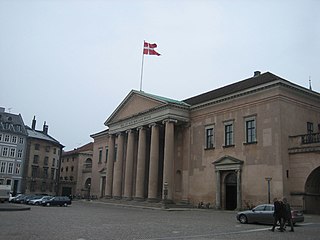
The Copenhagen Court House is a historic building located on Nytorv in Copenhagen, Denmark. Originally built as a combined city hall and courthouse, it now serves as the seat of the District Court of Copenhagen. Inaugurated in 1815, it was built to the design of Christian Frederik Hansen in Neoclassical style.

Arkitema Architects is a Danish architectural firm headquartered in Aarhus, with branch offices in Copenhagen, Malmö, Stockholm and Oslo. Arkitema Architects was founded in 1969 in Aarhus, and nowadays has about 400 employees with its main activity in Scandinavia.

A new, third City Hall in Copenhagen, Denmark, was built at Gammeltorv in 1479. Rebuilt by King Christian IV into the Renaissance style in 1610, it was in use until 1728 when it was destroyed in the first Great Fire of Copenhagen. It was replaced by a new city hall which was built on its foundations the same year.
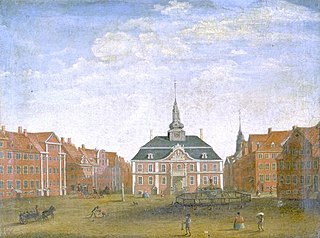
A new, fourth City Hall in Copenhagen, Denmark, was built between Gammeltorv and Nytorv in 1728 on the foundations of its predecessor which had been destroyed in the first Great Fire of Copenhagen earlier that same year. In 1795 it was itself destroyed in the second Great Fire of Copenhagen and later replaced by the new combined city hall and courthouse at Nytorv which was completed in 1815.
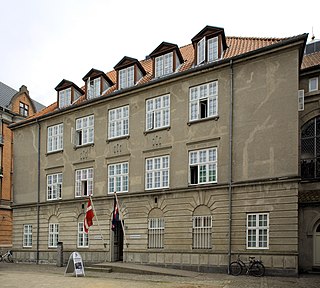
The Occupation Museum in Aarhus, Denmark is a history museum dedicated to the history of Aarhus during the German occupation in the Second World War.

Aarhus Old City Hall is the former city hall of Aarhus, Denmark, and a listed building. The city hall was built in 1857 and was listed in the Danish national registry of protected buildings and places by the Danish Heritage Agency on 18 March 1996. It is the second, and oldest preserved, city hall of Aarhus.

Holbæk Museum is a local history museum in Holbæk, Denmark. It is based in a large complex of historic, mostly half-timbered buildings from the 17th to 19th century surrounding a garden space. One of the buildings was moved to the site in 1937 but the others all stand in their original location. The museum also comprises a pilot boat from 1922 docked in Holbæk's harbor. Holbæk Museum has been part of Museum Vestsjælland since 1 January 2014.
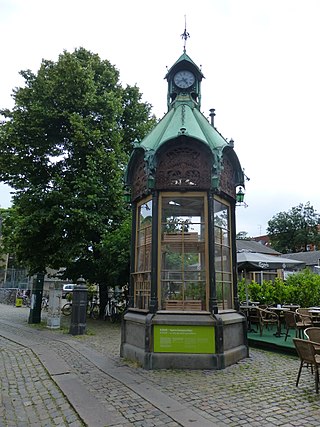
A/S Københavns Telefonkiosker, often referred to as KTK, was an operator of staffed telephone kiosks in Copenhagen, Denmark. The first telephone kiosks were installed in 1896 to an Art Nouveau-influenced National Romantic design by Fritz Koch. A new and somewhat larger model was introduced in 1913 but Koch's original design was again used when a number of new telephone kiosks were installed in 1929.

Gamle rådhus is a building with a long history in Oslo, Norway. It is one of the oldest buildings in the Norwegian capital. It was built as the first town hall in Christiania in 1641. The construction of the town hall got financial support by King Christian IV. The building has historically been used for many purposes. A restaurant was appointed in a side wing in 1856 and moved to the main house in 1925. From 1980 to 2010 a theatre museum was located in the side wing of the first floor. The Old Town Hall is listed and protected by law by the Norwegian Directorate for Cultural Heritage.
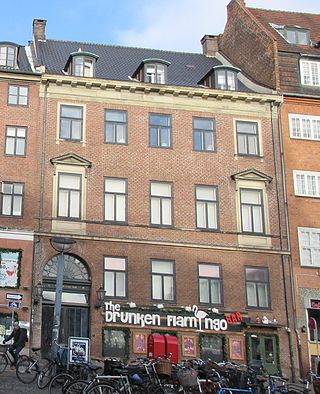
Hinrich Ladiges was a German-Danish sugar manufacturer. He owned two sugar refineries in Copenhagen and died as one of the wealthiest men in the country. He died unmarried and left much of his estate to charity. His former home at Gammeltorv 14, now known as the Holm House after a later owner, was listed on the Danish registry for protected buildings and places in 1926.
Stege Town Hall, situated at the corner of Rådhusgade and Storegade, is the former town hall of Stege on Møn, now part of Vordingborg Municipality, in southeastern Denmark. The Renaissance Revival style building was completed in 1854 to designs by Gottlieb Bindesbøll and served its original purpose for just over one hundred years. It was subsequently used as police station from 1968 to 2008. The building was listed on the Danish registry of protected buildings and places in 1979.




















